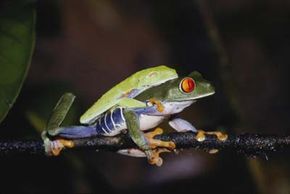Frog Reproduction, from Mating to Metamorphosis
Most people learn about the basics of frog reproduction in elementary school. Frogs lay eggs in water, and the eggs hatch into tadpoles that grow into frogs. Only about half of all frogs follow these exact steps, but there are a few rules of thumb about frog reproduction. All frogs reproduce sexually, and all hatch from eggs.
In almost all frogs, egg fertilization happens outside the female's body instead of inside. The female releases her eggs and the male releases his sperm at the same time. In order to make sure that the sperm reach the eggs, the male and female get into a mating posture called amplexus. The male climbs onto the female's back and clasps his forelegs around her middle. Frogs can stay in amplexus for hours or even days as the female releases as few as one or as many as several hundred eggs.
Advertisement
Sometimes, it's easy to tell male frogs from female frogs. Many species are sexually dimorphic, meaning that there are differences between the bodies and colors of males and females. But in some species, males and females are hard to tell apart. In such species, male frogs often produce a release call when clasped by another male. During mating season, researchers can use release calls to tell which frogs are male and which are female.
All frogs' eggs require moisture to develop, and most frogs abandon their eggs once they're fertilized. But not all eggs incubate underwater or without parental care. A few species carry their eggs in their vocal sacs or their abdomens. Others lay eggs in dry areas and keep the eggs moist with water or urine. Depending on the frog's species and the climate in which it typically lives, the eggs can hatch in a few days to a few weeks.
In a few species, fully formed froglets hatch from the eggs, but most of the time the frog starts its life as a tadpole. While adult frogs are carnivores, tadpoles can be vegetarians or omnivores. Some are filter feeders that eat algae, and others have teeth and can eat anything from rotting vegetation to other tadpoles. Either way, tadpoles tend to be voracious eaters -- it takes a lot of energy to complete their metamorphosis into frogs.

Tadpoles that live in temporary rainwater ponds often become frogs in a couple of weeks. The process can take months in species that live in permanent lakes, rivers and ponds. But most of the time, the transformation follows the same basic steps. First, the back legs begin to grow. Then, as the front legs are forming, the tadpole's internal organs began to change. It develops a pair of lungs so it will be able to breathe air, and its digestive system changes to accommodate its adult diet. The tail gradually disappears as it's absorbed into the body. When the froglet is ready to live on land, it usually has a little bit of tail left, but that gradually disappears.
Frog eggs and tadpoles are food for fish, birds and other animals, so most eggs don't survive to adulthood. Adult frogs have several enemies as well, including those that are microscopic. Next, we'll look at some of the threats to frogs' survival and how the absence of frogs could affect human life.
